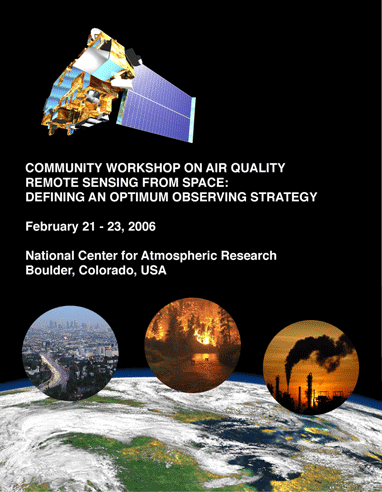COMMUNITY WORKSHOP ON AIR QUALITY REMOTE SENSING FROM SPACE:
DEFINING AN OPTIMUM OBSERVING STRATEGY

When: 21-23 February, 2006
Where: National Center for Atmospheric Research, Boulder CO
Recent advances in tropospheric remote sensing have opened the way for measuring,
monitoring and understanding processes that lead to atmospheric pollution. As part of an
integrated observing strategy, satellite measurements provide a context for localized
observations and help extend these to continental and global scales. The challenge for
future spaceborne missions will be directly accessing the local scale and facilitating
the use of remotely sensed information for improving local and regional-scale air
quality forecasts. Achieving this goal will pay important societal dividends for public
health, for policy applications related to managing national air quality, and for
assessing the impact of daily human activity on both chemical weather and climate.
The primary goal of this community meeting will be an examination of the key measurement
characteristics that are required for the successful use of satellite remote sensing in
measuring environmentally significant pollutant trace gases and aerosols from space. The
Workshop will have the following specific objectives:
- To provide an overview of current and future operational requirements for air quality satellite observations
- To review the current space-based capabilities for measuring tropospheric trace gases and aerosols and to assess the benefits and limitations for air quality applications
- To further the development of techniques for combining space-based measurements with models, particularly at the regional scale, for estimating sources and sinks, and separating the contributions of local production and transported pollution
- To examine the horizontal, vertical, and temporal measurement resolutions required to capture the variation of the important atmospheric constituents and processes determining air quality
- To explore future mission concepts and detail the parameters of an optimum observation system for air quality studies from space.
The National Academy of Science (NAS) is currently
conducting a Decadal Survey to
determine the priorities for the next round of space missions for
Earth Science and Applications from Space.
If any mission related to atmospheric composition is to become
a reality within the next decade, it is imperative that the atmospheric chemistry
community establishes its own set of key measurements. This workshop will constitute
part of the community input to the NASA Atmospheric Composition Working Group that will
be looking at the requirements for future NASA investments in atmospheric composition as
applied to climate variability, stratospheric ozone, as well as air quality. A report of
the Workshop proceedings will be published after the meeting.
The Workshop will be hosted by the
Atmospheric Chemistry Division of the
National Center
for Atmospheric Research, and will take place in NCAR Center Green Auditorium,
Boulder Colorado, February 21-23,
2006.
The meeting will be comprised of invited talks and an extended poster session. A limited
number of contributed talks will also be accepted. Further information can be found by
by contacting David Edwards
(edwards@ucar.edu, 303-497-1857). A limited number of grants will be available to
support the participation of early career scientists.
Organizing Committee
David Edwards, NCAR, Boulder CO Philip DeCola, NASA Headquarters, Washington DC Jack Fishman, NASA/LaRC, Hampton VA Daniel Jacob, Harvard University, Cambridge MA Pawan Bhartia, NASA/GSFC, Greenbelt MD David Diner, JPL, Pasadena CA John Burrows, University of Bremen, Bremen, Germany Mitch Goldberg, NOAA/NESDIS, Silver Spring, MD
